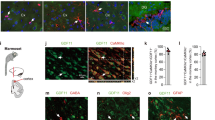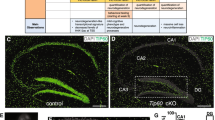Abstract
The anaphase promoting complex (APC) or cyclosome is a multi-subunit E3 ubiquitin ligase. Cdc20 (fizzy (fzy)) or p55CDC, and Cdh1 (Hct1, srw1 or fizzy-related 1 (fzr1)) encode two adaptor proteins that bring substrates to the APC. Both APC–Cdc20 and APC–Cdh1 have been implicated in the control of mitosis through mediating ubiquitination of mitotic regulators, such as cyclin B1 and securin. However, the importance of Cdh1 function in vivo and whether its function is redundant with that of Cdc20 are unclear. Here we have analysed mice lacking Cdh1. We show that Cdh1 is essential for placental development and that its deficiency causes early lethality. Cdh1-deficient mouse embryonic fibroblasts (MEFs) entered replicative senescence prematurely because of stabilization of Ets2 and subsequent activation of p16Ink4a expression. These results have uncovered an unexpected role of the APC in maintaining replicative lifespan of MEFs. Further, Cdh1 heterozygous mice show defects in late-phase long-term potentiation (L-LTP) in the hippocampus and are deficient in contextual fear-conditioning, suggesting that Cdh1 has a role in learning and memory.
This is a preview of subscription content, access via your institution
Access options
Subscribe to this journal
Receive 12 print issues and online access
$209.00 per year
only $17.42 per issue
Buy this article
- Purchase on Springer Link
- Instant access to full article PDF
Prices may be subject to local taxes which are calculated during checkout





Similar content being viewed by others
References
Li, M., York, J. P. & Zhang, P. Loss of Cdc20 causes a securin-dependent metaphase arrest in two-cell mouse embryos. Mol. Cell. Biol. 27, 3481–3488 (2007).
Stryke, D. et al. BayGenomics: a resource of insertional mutations in mouse embryonic stem cells. Nucleic Acids Res. 31, 278–281 (2003).
Laronne, A. et al. Synchronization of interphase events depends neither on mitosis nor on cdk1. Mol. Biol. Cell 14, 3730–3740 (2003).
Sorensen, C. S. et al. Nonperiodic activity of the human anaphase-promoting complex-Cdh1 ubiquitin ligase results in continuous DNA synthesis uncoupled from mitosis. Mol. Cell. Biol. 20, 7613–7623 (2000).
Edgar, B. A. & Orr-Weaver, T. L. Endoreplication cell cycles: more for less. Cell 105, 297–306 (2001).
Stewart, S. & Fang, G. Destruction box-dependent degradation of aurora B is mediated by the anaphase-promoting complex/cyclosome and Cdh1. Cancer Res. 65, 8730–8735 (2005).
Nguyen, H. G., Chinnappan, D., Urano, T. & Ravid, K. Mechanism of Aurora-B degradation and its dependency on intact KEN and A-boxes: identification of an aneuploidy-promoting property. Mol. Cell. Biol. 25, 4977–4992 (2005).
Lindon, C. & Pines, J. Ordered proteolysis in anaphase inactivates Plk1 to contribute to proper mitotic exit in human cells. J. Cell Biol. 164, 233–241 (2004).
Huang, J. N., Park, I., Ellingson, E., Littlepage, L. E. & Pellman, D. Activity of the APC(Cdh1) form of the anaphase-promoting complex persists until S phase and prevents the premature expression of Cdc20p. J. Cell Biol. 154, 85–94 (2001).
Wei, W. et al. Degradation of the SCF component Skp2 in cell-cycle phase G1 by the anaphase-promoting complex. Nature 428, 194–198 (2004).
Bashir, T., Dorrello, N. V., Amador, V., Guardavaccaro, D. & Pagano, M. Control of the SCF(Skp2–Cks1) ubiquitin ligase by the APC/C(Cdh1) ubiquitin ligase. Nature 428, 190–193 (2004).
Carrano, A. C., Eytan, E., Hershko, A. & Pagano, M. SKP2 is required for ubiquitin-mediated degradation of the CDK inhibitor p27. Nature Cell Biol. 1, 193–199 (1999).
Tsvetkov, L. M., Yeh, K. H., Lee, S. J., Sun, H. & Zhang, H. p27Kip1 ubiquitination and degradation is regulated by the SCF(Skp2) complex through phosphorylated Thr 187 in p27. Curr. Biol. 9, 661–664 (1999).
Bornstein, G. et al. Role of the SCFSkp2 ubiquitin ligase in the degradation of p21Cip1 in S phase. J. Biol. Chem. 278, 25752–25757 (2003).
Ohtani, N. et al. Opposing effects of Ets and Id proteins on p16INK4a expression during cellular senescence. Nature 409, 1067–1070 (2001).
Lasorella, A. et al. Degradation of Id2 by the anaphase-promoting complex couples cell-cycle exit and axonal growth. Nature 442, 471–474 (2006).
Gieffers, C., Peters, B. H., Kramer, E. R., Dotti, C. G. & Peters, J. M. Expression of the CDH1-associated form of the anaphase-promoting complex in postmitotic neurons. Proc. Natl Acad. Sci. USA 96, 11317–11322 (1999).
Fonseca, R., Vabulas, R. M., Hartl, F. U., Bonhoeffer, T. & Nagerl, U. V. A balance of protein synthesis and proteasome-dependent degradation determines the maintenance of LTP. Neuron 52, 239–245 (2006).
Kim, J. J. & Fanselow, M. S. Modality-specific retrograde amnesia of fear. Science 256, 675–677 (1992).
Phillips, R. G. & LeDoux, J. E. Differential contribution of amygdala and hippocampus to cued and contextual fear conditioning. Behav. Neurosci. 106, 274–285 (1992).
Yang, B. S. et al. Ras-mediated phosphorylation of a conserved threonine residue enhances the transactivation activities of c-Ets1 and c-Ets2. Mol. Cell. Biol. 16, 538–547 (1996).
McCarthy, S. A. et al. Rapid phosphorylation of Ets-2 accompanies mitogen-activated protein kinase activation and the induction of heparin-binding epidermal growth factor gene expression by oncogenic Raf-1. Mol. Cell. Biol. 17, 2401–2412 (1997).
Huot, T. J. et al. Biallelic mutations in p16INK4a confer resistance to Ras- and Ets-induced senescence in human diploid fibroblasts. Mol. Cell. Biol. 22, 8135–8143 (2002).
Jia, J., Lin, M., Zhang, L., York, J. P. & Zhang, P. The Notch signaling pathway controls the size of the ocular lens by directly suppressing p57Kip2 expression. Mol. Cell. Biol. 27, 7236–7247 (2007).
Paylor, R., Tracy, R., Wehner, J. & Rudy, J. W. DBA/2 and C57BL/6 mice differ in contextual fear but not auditory fear conditioning. Behav. Neurosci. 108, 810–817 (1994).
Acknowledgements
The authors thank Dr. H. Yu (Southwestern Medical Center, University of Texas) for technical help, and the transgenic core of BCM for microinjections. We thank E. Shin for excellent technical support. This work was supported in part by a NIH grant CA116097 (P.Z.) and NIH grants NS034007 and NS047384 (E.K.).
Author information
Authors and Affiliations
Contributions
M.L., E.R. and P.Z. planned the experiments; M.L., Y.-H. S. and L.H. performed the experimental work and data analyses; X.H. and Z.W. provided technical help; P.Z. wrote the manuscript.
Corresponding author
Ethics declarations
Competing interests
The authors declare no competing financial interests.
Supplementary information
Supplementary Information
Supplementary Figures S1, S2, S3, S4 and S5 (PDF 646 kb)
Rights and permissions
About this article
Cite this article
Li, M., Shin, YH., Hou, L. et al. The adaptor protein of the anaphase promoting complex Cdh1 is essential in maintaining replicative lifespan and in learning and memory. Nat Cell Biol 10, 1083–1089 (2008). https://doi.org/10.1038/ncb1768
Received:
Accepted:
Published:
Issue Date:
DOI: https://doi.org/10.1038/ncb1768
This article is cited by
-
Phosphorylation of the Anaphase Promoting Complex activator FZR1/CDH1 is required for Meiosis II entry in mouse male germ cell
Scientific Reports (2020)
-
Insights into APC/C: from cellular function to diseases and therapeutics
Cell Division (2016)
-
Aβ Induces Excitotoxicity Mediated by APC/C-Cdh1 Depletion That Can Be Prevented by Glutaminase Inhibition Promoting Neuronal Survival
Scientific Reports (2016)
-
Mice lacking the PSD-95–interacting E3 ligase, Dorfin/Rnf19a, display reduced adult neurogenesis, enhanced long-term potentiation and impaired contextual fear conditioning
Scientific Reports (2015)
-
APC/C-Cdh1 coordinates neurogenesis and cortical size during development
Nature Communications (2013)



